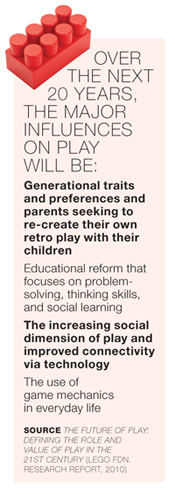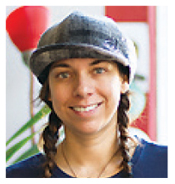The Future of Play | Designing the Future
Virtual and augmented reality hold promise—especially if playtime gets its due
 THE PLAY GAP
THE PLAY GAP  To Rivkah Sass, executive director, Sacramento Public Library (SPL), CA, there is no greater enemy to young children than the “play gap”—the shrinking time to explore, invent, and run amok that’s given way to test prep, shortened recess periods, and scheduled downtime. Sass feels passionately that libraries are not only an optimum space for children to play but also where parents, caregivers, and educators can learn how to support this key building block for literacy.
To Rivkah Sass, executive director, Sacramento Public Library (SPL), CA, there is no greater enemy to young children than the “play gap”—the shrinking time to explore, invent, and run amok that’s given way to test prep, shortened recess periods, and scheduled downtime. Sass feels passionately that libraries are not only an optimum space for children to play but also where parents, caregivers, and educators can learn how to support this key building block for literacy.
“If we don’t address this, then when [children] start or are in school they’re not going to get as much time to play,” Sass says. “Recess doesn’t really exist as it did when I was a child.”
Hence, the Sacramento Play Summit (SPS), a partnership between the SPL and Fairytale Town, a one-day program for parents, teachers, caregivers, and librarians to discuss play, why it’s important, and how to bring more of it to children.
Now in its fourth year, SPS brings together about 240 individuals. There are sessions on organization, how to encourage play with found objects, and how play impacts child development.
Kathy Fleming, who’s been executive director of Fairytale Town for 16 years, like Sass, has seen the freedom to explore, invent, and discover shrink as children’s time has become more scheduled and even the physical ability to explore curtailed. That is a loss not only to the child but to the community as a whole.
“This is an opportunity for libraries,” says Sass. “It’s critical [that we] make space for play and customize it to the services we provide. If we don’t own it, if we don’t take this on as ours, it’s going to turn into something that isn’t play. We can do better.”—Lauren Barack
 Play Anything: The Pleasure of Limits, the Uses of Boredom, and the Secret of Games by Ian Bogost (Basic: Perseus, Sept. 2016) Power Play: How Video Games Can Save the World by Asi Burak and Laura Parker (St. Martin’s, Jan. 2017)
Play Anything: The Pleasure of Limits, the Uses of Boredom, and the Secret of Games by Ian Bogost (Basic: Perseus, Sept. 2016) Power Play: How Video Games Can Save the World by Asi Burak and Laura Parker (St. Martin’s, Jan. 2017) New Realities
 Meghan Athavale, CEO, Lumo Interactive, talks to LJ about the evolution of play and what’s coming next.
Meghan Athavale, CEO, Lumo Interactive, talks to LJ about the evolution of play and what’s coming next.
Dolls and toys have always represented anthropomorphic symbols for children. The difference is...children engage with technology almost [indistinguishably from how] they would with a person. There are a lot of alarmists wondering if we’re killing the imagination for children. In their minds, if a toy talks back to you, you’re killing their sense of creativity. I would argue it isn’t.
How are augmented reality (AR) games, such as Pokémon GO, affecting how children see their world?There are more situations where the physical and virtual spaces coexist. If you look at the earth, there aren’t actually physical lines where countries are; they are imagined, and those boundaries make up our political society. But they are virtual, and we are comfortable with those constructs. Technology allows us to superimpose this. I think this will change the way children perceive the world around them.
Where do you see play heading?There are certain types of toys that are extremely creative [and] allow children to manipulate objects but also teach the fundamental building blocks of how technology in our society works. One danger is that there is a strong possibility that if technology looks like magic, then people will start selling snake oil. It’s important at a young age to give children the opportunity to be creative and to learn how the magic works, so they make a responsible decision about it.
What role can libraries take?First, they can give children the tools, such as Maker spaces. Second, they can teach kids how to teach themselves, by teaching children how to use modern tools and do their own research. Third, they can ask kids what problem would they like to solve in their community and give them the tools to [do so]. It gives them a chance to see projects through to the end but also teaches them in a more rewarding fashion than following a kit.—LB
RELATED
ALREADY A SUBSCRIBER? LOG IN
We are currently offering this content for free. Sign up now to activate your personal profile, where you can save articles for future viewing









Add Comment :-
Comment Policy:
Comment should not be empty !!!